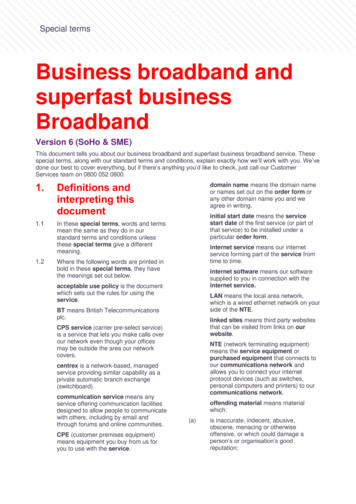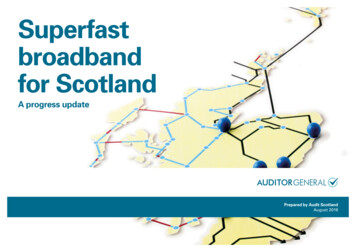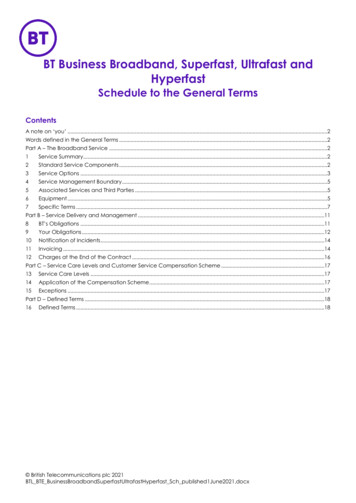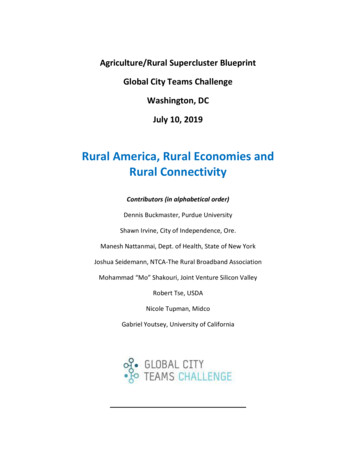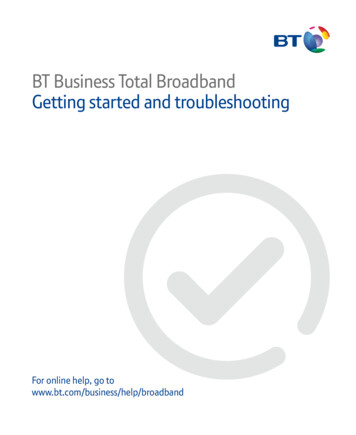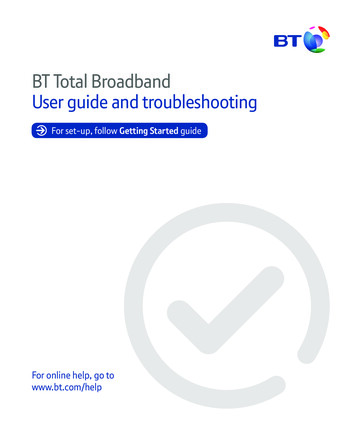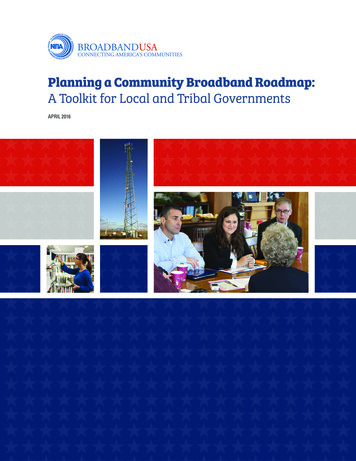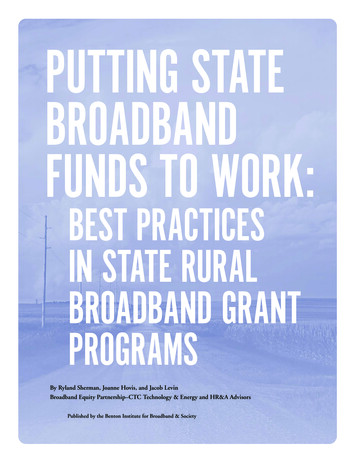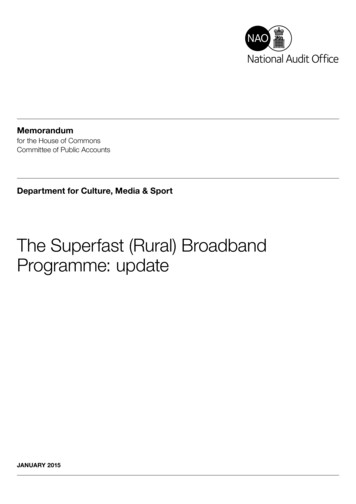
Transcription
Memorandumfor the House of CommonsCommittee of Public AccountsDepartment for Culture, Media & SportThe Superfast (Rural) BroadbandProgramme: updateJANUARY 2015
Our vision is to help the nation spend wisely.Our public audit perspective helps Parliament holdgovernment to account and improve public services.The National Audit Office scrutinises public spending for Parliament and isindependent of government. The Comptroller and Auditor General (C&AG),Sir Amyas Morse KCB, is an Officer of the House of Commons and leads theNAO, which employs some 820 employees. The C&AG certifies the accounts ofall government departments and many other public sector bodies. He has statutoryauthority to examine and report to Parliament on whether departments and thebodies they fund have used their resources efficiently, effectively, and with economy.Our studies evaluate the value for money of public spending, nationally and locally.Our recommendations and reports on good practice help government improvepublic services, and our work led to audited savings of 1.1 billion in 2013.
ContentsOverview 4Part OneIntroduction 8Part TwoPublishing information on broadbandcoverage and speed 12Part ThreePhase 1 cost data: informingphase 2 procurement 14Part FourPromoting competition 20Part FivePhase 1 progress and phase 2early progress 24Appendix OneOur previous recommendations,and those of the Committee ofPublic Accounts 28This report can be found on theNational Audit Office website atwww.nao.org.ukFor further information about theNational Audit Office please contact:National Audit OfficePress Office157–197 Buckingham Palace RoadVictoriaLondonSW1W 9SPTel: 020 7798 7400Enquiries: www.nao.org.uk/contact-usLinks to external websites were valid at the time ofpublication of this report. The National Audit Officeis not responsible for the future validity of the links.Website: www.nao.org.ukTwitter: @NAOorguk
4 Overview The Superfast (Rural) Broadband Programme: updateOverview1The government has made broadband internet provision a policy priority,citing the economic and social benefits. The Department for Culture, Media & Sport(the Department) is responsible for the government’s broadband policies. BroadbandDelivery UK (BDUK) – a unit within the Department – runs several programmes toprovide superfast broadband and better mobile connectivity to the UK. One of theseis the Superfast Broadband Programme (formerly the Rural Broadband Programme),which it has designed to provide superfast broadband across the UK in 3 phases: Phase 1 is to extend superfast broadband coverage to 90% of UK premisesby December 2016, with 530 million of central government funds. Phase 2 is to extend superfast broadband coverage to 95% of UK premisesby December 2017, with a further 250 million of central government funds. Phase 3 is to test options for rolling out superfast broadband past 95% coverage,with pilot projects complete by March 2016. Funding for the pilots is 10 million.2We reported on The Rural Broadband Programme in July 2013. That report lookedat the early procurement stages of phase 1 of the Superfast Broadband Programme(the Programme), and the prospect for getting value for money given the adequacy ofthe Programme’s controls and progress so far. The Committee of Public Accounts hassince published 2 reports: the first in September 2013 and the second in April 2014.Both reports highlighted concerns over: publishing superfast broadband rollout information; cost data being available and transparent; and the level of competition secured.3This memorandum outlines progress on those specific issues the Committee ofPublic Accounts raised. We also give a brief update on the Programme’s overall progress.
The Superfast (Rural) Broadband Programme: update Overview 5ProgressRollout plans: availability and quality4Many more local bodies (a local authority, group of local authorities, devolvedgovernment or local economic partnership) have published detailed information onbroadband coverage and expected rollout. All local bodies have published either mapsor postcode checkers, so consumers and businesses can identify current and plannedcoverage within local bodies. Most local bodies have published both. There remainssome variability in the quality of the maps. Recently, the Department has also publisheda national postcode checker that allows the public to find out the availability of superfastbroadband in their area.Cost data5BDUK has advised and supported local bodies in managing in-life controls such asstandardised reporting of costs and outputs over phase 1 of the Programme. BDUK’sanalysis of cost data for phase 1 showed that BT’s reported capital costs are so far 142 million lower than in its original bids, including 34 million in project managementcosts. However, BT has provided some of the cheaper and easier street cabinets so far,so costs are likely to increase as it starts to build the more complex solutions. BDUK’sexperience of actual costs in phase 1 has led to BT agreeing to submit lower costs inits financial model for phase 2, which will reduce the amount of public funding required.6To understand whether BT’s contracts were economically priced, BDUKcommissioned Atkins to do a small-scale trial cost comparison exercise. In January 2015this exercise reported that, for specific infrastructure in one location, BT had charged thepublic sector approximately 20% less than the estimated cost for an alternative supplier.7BDUK has not omitted confidentiality clauses from phase 2 contracts as theCommittee had hoped. However, BDUK considers it gets enough assurance from itsactual cost comparisons of local authority data. The Major Projects Authority recentlycited the BDUK’s ‘Milestone-to-Cash’ process, linking payments to project completionmilestones, as an example of best practice in controlling costs. Local bodies have alsoreported that they have found the cost comparison reports useful.
6 Overview The Superfast (Rural) Broadband Programme: updateCompetition8The Committee’s third concern was on getting more competition from future BDUKbroadband funding. Despite the limited competition in phase 1, BDUK did not prepare aseparate business case to decide the best delivery model for phase 2. It did engage withthe market and explore several options, but it did not fully develop or cost these options.In BDUK’s view doing so would have led to the same outcome but would have delayedthe phase 2 rollout. Once BDUK had decided to use the same delivery model as phase 1,local bodies undertook market engagement to identify potential suppliers. They alsoconducted open market reviews and consultations to identify other planned coverage.In the end, 43 of 47 local bodies have opted to use BDUK’s procurement framework formost or all of their phase 2 funding. Phase 2 will therefore have limited competition, asBT is now the only participant on the framework. However, 10 local bodies which havechosen to use the framework are considering keeping a minority of their funding back,which they may use for other procurements outside of the framework.9Overall, the effect of the first 2 phases will be to reinforce BT’s already strongposition in the wholesale market for broadband infrastructure (the Wholesale Local AccessMarket). BT’s assets and infrastructure will benefit from approximately 1.7 billion of publicsector investment although BT must maintain these assets at its own expense. BT is alsorequired by regulatory conditions to provide wholesale access to other suppliers.10 Phase 3 had significant competition for the pilot projects to test how to bringsuperfast broadband to the final 5% of the UK. BDUK has also been working on howto maximise how the public sector uses its network infrastructure assets.Phase 1: progress11 Phase 1 of the Programme is progressing well. It is on track for superfastbroadband to reach 90% of premises by early 2016. So far, significant cost savings andhigher than predicted take-up should bring greater coverage than contracted, as localbodies will be able to extend their rollout with remaining funds.
The Superfast (Rural) Broadband Programme: update Overview 7Looking ahead12 It is likely that if the government commits funding for superfast broadband for thefinal 5% of premises, it will use alternative technologies and funding models much more,which should increase competition. BDUK must manage smaller suppliers’ needs, touse any extra future funding effectively. BDUK should then be in a stronger positionto negotiate favourable contractual terms while balancing the specific challengesassociated with using smaller suppliers.13 BDUK’s value-for-money controls are an important safeguard against the possibilityof a supplier charging unreasonable costs. Its detailed review of phase 1 costs will bringsavings in phase 2 bid pricing. And the pilot cost comparison exercise commissionedby BDUK found that BT had charged the public sector approximately 20% less than theestimated cost for an alternative supplier. BDUK intends to strengthen its assurance thatBT’s contracts were economically priced further by repeating this ‘should cost’ exercisein other locations and for other solutions.14 Take-up of superfast broadband so far has been significantly faster than forecastby BT in the phase 1 contracts. Take-up has risen to more than 20% already for2 non‑framework projects. Both BT and the public sector will share the benefits ofany extra profit resulting from higher take-up for the first 7 years after rollout throughthe contract’s clawback clause. After these 7 years, the supplier will keep all of theextra wholesale profit. Funds that are clawed back because of greater take-up canbe reinvested. BDUK will need to help local bodies to reinvest funds while they arecontracting and rolling out their phase 2 projects.
8 Part One The Superfast (Rural) Broadband Programme: updatePart OneIntroduction1.1 Broadband is ‘always-on’ internet access named because of its bandwidth – thetotal data transferred per second. Broadband provision is measured in millions of bitsper second (Mbps). When the bandwidth achieves a certain level this is ‘superfast’broadband. The Department for Culture, Media & Sport (the Department) has definedsuperfast broadband as a bandwidth of 24 Mbps or more.1.2 Commercial operators such as BT and Virgin are rolling out superfast broadbandwhere profitable. As at December 2014, the commercial rollout of superfast broadbandwas expected to reach approximately 76% of UK premises. But the commercial case forproviding similar services to the remaining, often rural, communities is more challenging.Higher infrastructure costs and lower population density may make it unprofitable forpotential suppliers to invest.1.3 The government has made broadband internet provision a policy priority, citing themany economic and social benefits. Given this importance, the government intervenedin the market and gave public subsidy to suppliers to provide superfast broadbandto areas where provision is not commercially viable. The Department manages thegovernment’s broadband policies.1.4 A unit within the Department – Broadband Delivery UK (BDUK) – carries out thegovernment’s broadband programmes. BDUK manages a portfolio of programmesto provide superfast broadband and better mobile connectivity to the UK. These arethe Super-Connected Cities Programme, the Mobile Infrastructure Project, and theSuperfast Broadband Programme (formerly the Rural Broadband Programme). The lastof these has 3 separate phases (Figure 1).
The Superfast (Rural) Broadband Programme: update Part One 9Figure 1BDUK’s programmes for superfast broadband and better mobile connectivitySuper-ConnectedCities Programme 150 millionSuperfast BroadbandProgrammeMobileInfrastructureProject 790 millioncommitment to 2017 150 millionPhase 1: 90%of the UK byDecember 2016Phase 2: 95%of the UK byDecember 2017 530 million 250 millionPhase 3: Pilots foroptions for nearuniversal coverageby March 2016 10 millionOut of scope of memorandumCovered by National Audit Office update memorandumSource: National Audit OfficeThe Superfast Broadband Programme1.5 BDUK manages the Programme for the Department. BDUK designed theProgramme to get superfast broadband to areas, predominantly rural, wherecommercial providers had no plans to invest. The Department has committed 790 million of central government funding to the Programme, set out over 3 phases(Figure 2 overleaf).1.6 Phases 1 and 2 of the Programme involve the Department giving grant fundingto local bodies (a local authority, group of local authorities, devolved government orlocal economic partnership). There are 44 local bodies in phase 1 and 47 in phase 2.1These local bodies procure the infrastructure for superfast broadband for their areas.The Department developed a framework contract which local bodies can use to buythe services from a supplier. BT and Fujitsu were appointed as framework suppliers,although Fujitsu did not bid for projects and withdrew prior to phase 2. Local bodies mayalso procure the infrastructure for superfast broadband without using the framework.BDUK advises and supports each local body during procurement and subsequentcontract management. Local bodies must generally provide matched funding to thecentral government grant, and can also add extra money if they want. Total estimatedpublic sector funding for phases 1 and 2 is approximately 1.7 billion. Both phases1 and 2 use a gap funding model, where the gap is the public contribution requiredto supplement a supplier’s investment in broadband infrastructure to make a projectcommercially viable.1The 44 local bodies are listed in Figure 4 of our July 2013 report. The 47 local bodies include many of the same bodiesas for phase 1. Local bodies in phase 2 but not phase 1 include Cornwall, Cotswolds and Black Country.
10 Part One The Superfast (Rural) Broadband Programme: updateFigure 2The Superfast Broadband Programme’s objectivesPhaseObjectiveBDUK fundingProject approachTarget delivery datePhase 1To secure delivery ofsuperfast broadband to90% of UK premises byDecember 2016. 530m44 projects run bylocal bodiesDecember 2016Phase 2To extend delivery ofsuperfast broadband to95% of UK premises byDecember 2017. 250m47 projects run bylocal bodiesDecember 2017Phase 3To test options to rolloutsuperfast broadband tothe final 5% of the UK. 10m8 pilot projectswith differentsuppliersMarch 2016(pilot stage only)Source: National Audit Office review of BDUK documentation1.7 BDUK talked to potential suppliers in 2013, and those discussions indicated thatthe Department would need new solutions to extend superfast broadband coveragebeyond 95%. BDUK designed phase 3 of the Programme to test the options to rolloutsuperfast broadband to the final 5% of UK premises. In June 2014, following bids from26 suppliers, BDUK contracted directly with 8 suppliers to trial several technologies andoperating models to get superfast broadband to the hardest-to-reach communities. Pilotprojects that are successful in their feasibility stage will run until March 2016. BDUK isfunding these projects, with support from those local bodies that have agreed to hostthe pilot projects.Previous work and scope of this review1.8 In July 2013, we published a value-for-money study looking at phase 1 of theRural Broadband Programme.2 At that time about half the local bodies had completedtheir procurement. Rollout was still in early stages, even for local bodies that had beenfirst to sign contracts. We did not conclude on whether the Programme had beenvalue for money. Instead we examined how well the Department designed the RuralBroadband Programme and the extent to which the combined set of safeguards wouldgive assurance about the value for money of the subsidy. We also considered theDepartment’s progress in its Programme. Our report concluded that the Programmelacked competitive tension and strong assurance over costs. Therefore, ensuring valuefor money would rely heavily on the quality of the in-life contract controls the Departmentdesigned for the Programme. We also pointed to early delays in the Programme’sprocurement phase.2Comptroller and Auditor-General, The Rural Broadband Programme, Session 2013-14, HC 535,National Audit Office, July 2013.
The Superfast (Rural) Broadband Programme: update Part One 111.9 The Committee of Public Accounts held a hearing in July 2013 and a follow‑uphearing in January 2014 on this topic. The Committee set out its concerns in 2 reports.3Concerns included the lack of competition in contracts, and whether the contracts,including the supplier contribution and contractual terms, were good value for money.Concerns also covered a lack of transparency over BT costs and limited publishedinformation about planned rural broadband coverage and speed.1.10 This memorandum gives an update on 3 specific issues where the Committee feltthe Department needed to progress further following the government’s latest TreasuryMinute response.4 These are: publishing coverage and speed information for phase 1; using cost information collected for phase 1, and how this is informing contractnegotiations for phase 2; and how BDUK has promoted competition, including reasons for its procurementapproaches for phases 2 and 3, and how much competition it has secured.This memorandum gives an update on the Programme’s progress, including on rolloutand take-up of superfast broadband under phase 1 and comments on initial progressfor phase 2. We do not provide a wider assessment of the Programme, or reach avalue‑for-money conclusion.34HC Committee of Public Accounts, The rural broadband programme, Twenty-fourth Report of Session 2013‑14,HC 474, September 2013 and HC Committee of Public Accounts, The rural broadband programme, Fiftieth Reportof Session 2013-14, HC 834, April 2014.Treasury Minute, Government response on the Fiftieth Report from the Committee of Public Accounts,Session 2013‑14, Cm 8871, June 2014.
12 Part Two The Superfast (Rural) Broadband Programme: updatePart TwoPublishing information on broadband coverageand speed2.1 Publishing detailed information on broadband coverage and speed is important.Potential suppliers planning broadband projects find maps useful in finding out whereothers already intend to operate, so they can plan their own projects to best effect.Individuals may want to know when they will get superfast broadband, and may usea postcode checker to find out.2.2 The Committee of Public Accounts heard in its previous sessions that BT considersthe detailed speed and coverage templates in its contracts with local bodies to becommercially confidential. Potential competitors also said that other projects werestalling because they could not get funding from other sources without information toshow that their proposed programme did not threaten competitors’ existing plans. BTsaid at the January 2014 hearing that it did not object to local bodies publishing detailedrollout plans and would support them to do so.2.3 In 2014, Broadband Delivery UK (BDUK) worked with local bodies on makingdetailed and high‑quality rollout information available. The detailed information formspart of the contract between local bodies and BT, so BDUK would not release thedata itself. However, BDUK used several methods to encourage local authorities topublish information. The Department has written 3 letters to senior staff at local bodies,in July 2013, February 2014 and July 2014. These letters encouraged local bodies topublish data, and offered support to do so. BDUK and local bodies also got a ‘letter ofcomfort’ from BT that it will not take legal action against local bodies that use coveragedata from the speed and coverage templates to support published maps and postcodecheckers.5 BT and local bodies formalised this agreement in contract variations. Finally,BDUK includes this topic in its regular update calls and visits with local bodies.2.4 In January 2014 BT told the Committee that 40 out of 44 local bodies hadpublished some information on broadband coverage, typically as maps. However, themaps’ quality varied, with many not showing detailed plans. We looked at publishedmaps and postcode checkers as at January 2015. Figure 3 shows the results.5In allowing local bodies to publish detailed rollout information, BT stipulated that local bodies must not publish widerproject deployment data and must recognise that deployment plans could be subject to change, for example followingdetailed survey work by BT.
The Superfast (Rural) Broadband Programme: update Part Two 13Figure 3Availability of rollout information on phase 1 projects, at 1 January 2015Availability of maps and postcode checkersNumber of local bodiesPostcode checker and detailed mapping30Postcode checker and less detailed mapping10Postcode checker only2Enhanced detail mapping only2Total44Source: National Audit Office analysis2.5 Since the January 2014 Committee hearing both the availability and quality ofrollout plans has improved. All local bodies now have information about rollout on theirwebsites using either mapping or postcode checkers. Of 44 project websites, 42 had amap, and 42 had postcode checkers. There is still variation in the detail in rollout maps.Many maps had much detail, with postcode data sometimes shown to street level. Ouranalysis showed that two-thirds (30) of local project websites now have both detailedmaps and postcode checkers. Only a quarter of projects have not published detailedmaps, although they had postcode checkers. Most project websites had summaryinformation on areas that would get superfast speeds. Some local bodies also provideinformation such as which specific BT street cabinets have been, or are scheduled for,an upgrade.2.6 BDUK launched an advertising and marketing campaign in December 2014 toencourage greater consumer take-up of superfast broadband. This campaign gives onecentral postcode checker with current information on superfast broadband coverage, toimprove the information available.66The website for this postcode checker is at www.gov.uk/gosuperfast
14 Part Three The Superfast (Rural) Broadband Programme: updatePart ThreePhase 1 cost data: informing phase 2 procurement3.1 The Committee of Public Accounts’ September 2013 and April 2014 reportsraised concerns over the cost transparency of BT’s bids. It questioned whetherBroadband Delivery UK (BDUK) had enough assurance that BT’s calculation of the bid costsand the public subsidy needed to make the funding commercially viable were reasonable.3.2 Our previous work found the Department for Culture, Media & Sport(the Department) had limited transparency over BT’s forecast costs in its model. Also,a non-disclosure agreement in the contract prevented local bodies from sharing costinformation. BDUK did compare tender prices between local bids, which helpedlocal bodies. However, the analysis lacked unit costs, a comprehensive ‘shouldcost’ model, or wider benchmarks for many costs. During the project, BT may onlyclaim for evidenced eligible expenditure, which helps to safeguard public funds. TheCommittee remained concerned that in-life controls do not affect whether the costswere economically priced in the first place. The Department assured the Committee thatit would review the non-disclosure agreements and would collect detailed deploymentcosts once available.3.3 In this review we followed up on previous concerns by looking at cost informationso far and how these data inform phase 2 bids. We did not do a detailed review ofwhether BDUK’s in-life controls are acceptable. Rather, we looked at BDUK’s analysis ofthe available cost data.
The Superfast (Rural) Broadband Programme: update Part Three 15BDUK’s in-life controls over phase 1 costs3.4 Now that phase 1 of the Superfast Broadband Programme (the Programme) is indelivery, BDUK has strengthened its value-for-money team and its work on in-life controls.Local bodies pay BT on the basis of a ‘Milestone-to-Cash’ process to get assuranceover the payments for milestones, which promotes good cost control. BDUK has accessto detailed cost information collected on each of the local projects that used the BDUKprocurement framework.7 BDUK’s value-for-money team is highly skilled. Its support tolocal bodies includes: a standardised assurance approach that directly links each project’s deliverablesand costs required for these, supported by guidance and checklists; review of key processes and controls that underpin the supplier’s key costs, includingguidance for local bodies on how to build project management cost forecasts; visits to all local bodies to assess and support assurance processes; regional meetings and regular briefings and clinics which allow BDUK to promotebest practice, share knowledge, discuss common issues and to give advice. quarterly cost comparison reports for each local project, which compare keymeasures against the equivalent data from all local bodies (supplemented by BDUK’svalue-for-money team having individual tailored discussions on these reports).3.5 The Major Projects Authority carried out a project assessment review in autumn2014. It concluded that “The ‘Milestone-to-Cash’ process should be disseminated acrossWhitehall, as appropriate, as an exemplar of best practice”.8Phase 1 actual cost data3.6 The contracts between BT and local bodies require BT to bear the risk ofoverspends, so these contracts effectively set BT’s maximum claim amount for eachproject. It therefore made good financial sense for BT to include some contingency in itsbids. BT told the Committee in July 2013 that it typically included 5% to 8% contingencyin project bids.3.7 BDUK’s analysis of the cost information it has received suggests that so far actualphase 1 costs are significantly lower than BT’s financial model. As at September 2014,BT’s total reported capital spend on phase 1 of the Programme was 142 million (38%)under the estimated price, including work in progress not yet invoiced. BDUK estimatesthat this 142 million variance reported so far is likely to be reduced by between 30 and 50 million. This is partly because of timing issues, as BT’s financial model profiled averageunit costs, rather than profiling projected specific unit costs. There are also some possiblefurther costs not yet charged by BT. But even if all of these costs materialise, BT would stillhave spent approximately 92 million (25%) less than its contracted forecast cost.78BDUK detailed data exclude the following projects, which are not following the ‘milestone to cash’ process: Wales,Lancashire, Surrey, Rutland, Northern Ireland, North Yorkshire, Herefordshire and Gloucestershire, Cumbria and Cheshire.Major Projects Authority, Project Assessment Review: Broadband portfolio, October 2014.
16 Part Three The Superfast (Rural) Broadband Programme: update3.8 Phase 1 costs are so far lower than BT’s model in all categories (Figure 4): Fibre to the cabinet costsStreet cabinets are a link between individual premises, which often have coppertelephone wires, and fibre-optic cable in the wider network. BDUK calculated theaverage cost per cabinet as at September 2014 at 21,100, which is markedly lowerthan the average bid cost per cabinet of 28,900 calculated in July 2013.9 BT hasrolled out 26% of cabinets, covering 22% of premises. However, BT has providedsome of the cheaper and easier cabinets so far. The average cost may increaseas BT builds the more complex cabinets, so it is difficult to estimate final costsat this stage. Fibre to the premises costsBT’s model spread the costs of enabling fibre-optic cable direct to premises evenlythroughout the project, whereas it actually planned to build more towards theproject end. Even where projects are almost complete, BDUK reports that BT’srollout programmes are using street cabinets more than its original model plannedand less fibre direct to premises. This change is likely to reduce total project costs,as providing fibre directly to premises is, on average, more expensive than installingstreet cabinets. Other capital expenditure (includes improvements to BT’s incremental corenetwork to support BDUK deployment)BDUK analysis shows that expenditure is less than half of the bid model costs. Project management costsBDUK has accrued 33.7 million of savings to September 2014 compared withBT’s projected project management costs. (Figure 5 on page 18). BDUK predictstotal savings of approximately 72 million by 2017-18. These savings have arisenpartly due to economies of scale and synergies from running all 44 contracts, anddue to the standardised approach to ‘milestone-to-cash’ reporting. Actual projectmanagement costs charged by BT are very similar to estimates prepared bylocal bodies of what project management costs would be appropriate. This givesconfidence that BDUK’s estimated saving on project management costslooks reasonable.3.9 Several factors may yet affect any final difference between BT’s bid costs and actualcosts claimed, including the exact technical solutions used. However, BDUK predicts thatsignificant overall cost savings are likely. Such savings will suggest how effective BDUK’sin-life controls were, and reflect the contingency BT built into the bids to take account ofthe risk it bears.9The average cost per cabinet in bids was based on the 18 English local body bids received by July 2013.
The Superfast (Rural) Broadband Programme: update Part Three 17Figure 4BDUK’s analysis of BT’s actual versus modelled capital costs,at September 2014Actual costs claimed are lower than those modelled in all categoriesCost category176.7mFibre to the cabinet169.7m61.8mFibre to the premises6.3m77.8mOther capital expenditure32.1m52.6mProject management18.8m050100150200Cost ( m)Modelled costActual costNotes1 These data exclude 9 projects that are not using the ‘milestone-to-cash’ approach.2‘Fibre to the cabinet’ costs include work-in-progress, and so are no
1.1 Broadband is 'always-on' internet access named because of its bandwidth - the total data transferred per second. Broadband provision is measured in millions of bits per second (Mbps). When the bandwidth achieves a certain level this is 'superfast' broadband. The Department for Culture, Media & Sport (the Department) has defined
